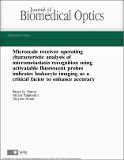Microscale receiver operating characteristic analysis of micrometastasis recognition using activatable fluorescent probes indicates leukocyte imaging as a critical factor to enhance accuracy
Author(s)
Spring, Bryan Q.; Palanisami, Akilan; Hasan, Tayyaba
DownloadSpring-2014-Microscale receiver.pdf (3.301Mb)
PUBLISHER_POLICY
Publisher Policy
Article is made available in accordance with the publisher's policy and may be subject to US copyright law. Please refer to the publisher's site for terms of use.
Terms of use
Metadata
Show full item recordAbstract
Molecular-targeted probes are emerging with applications for optical biopsy of cancer. An underexplored potential clinical use of these probes is to monitor residual cancer micrometastases that escape cytoreductive surgery and chemotherapy. Here, we show that leukocytes, or white blood cells, residing in nontumor tissues—as well as those infiltrating micrometastatic lesions—uptake cancer cell-targeted, activatable immunoconjugates nonspecifically, which limits the accuracy and resolution of micrometastasis recognition using these probes. Receiver operating characteristic analysis of freshly excised tissues from a mouse model of peritoneal carcinomatosis suggests that dual-color imaging, adding an immunostain for leukocytes, offers promise for enabling accurate recognition of single cancer cells. Our results indicate that leukocyte identification improves micrometastasis recognition sensitivity and specificity from 92 to 93%—for multicellular metastases >20 to 30 μm in size—to 98 to 99.9% for resolving metastases as small as a single cell.
Date issued
2014-06Department
Harvard University--MIT Division of Health Sciences and TechnologyJournal
Journal of Biomedical Optics
Publisher
SPIE
Citation
Spring, Bryan Q., Akilan Palanisami, and Tayyaba Hasan. “Microscale Receiver Operating Characteristic Analysis of Micrometastasis Recognition Using Activatable Fluorescent Probes Indicates Leukocyte Imaging as a Critical Factor to Enhance Accuracy.” Journal of Biomedical Optics 19, no. 6 (June 1, 2014): 066006. © 2014 Society of Photo-Optical Instrumentation Engineers
Version: Final published version
ISSN
1083-3668
1560-2281